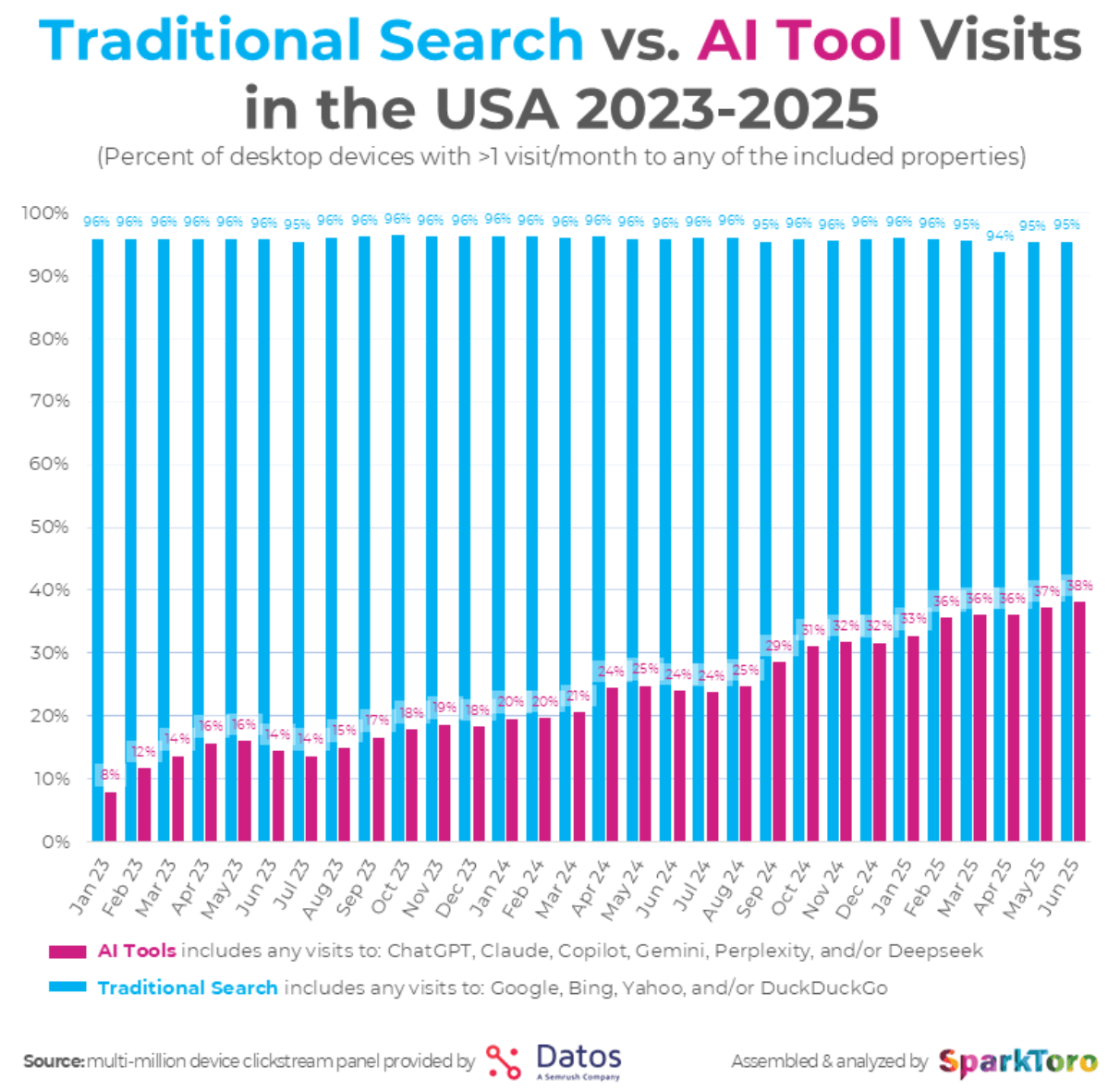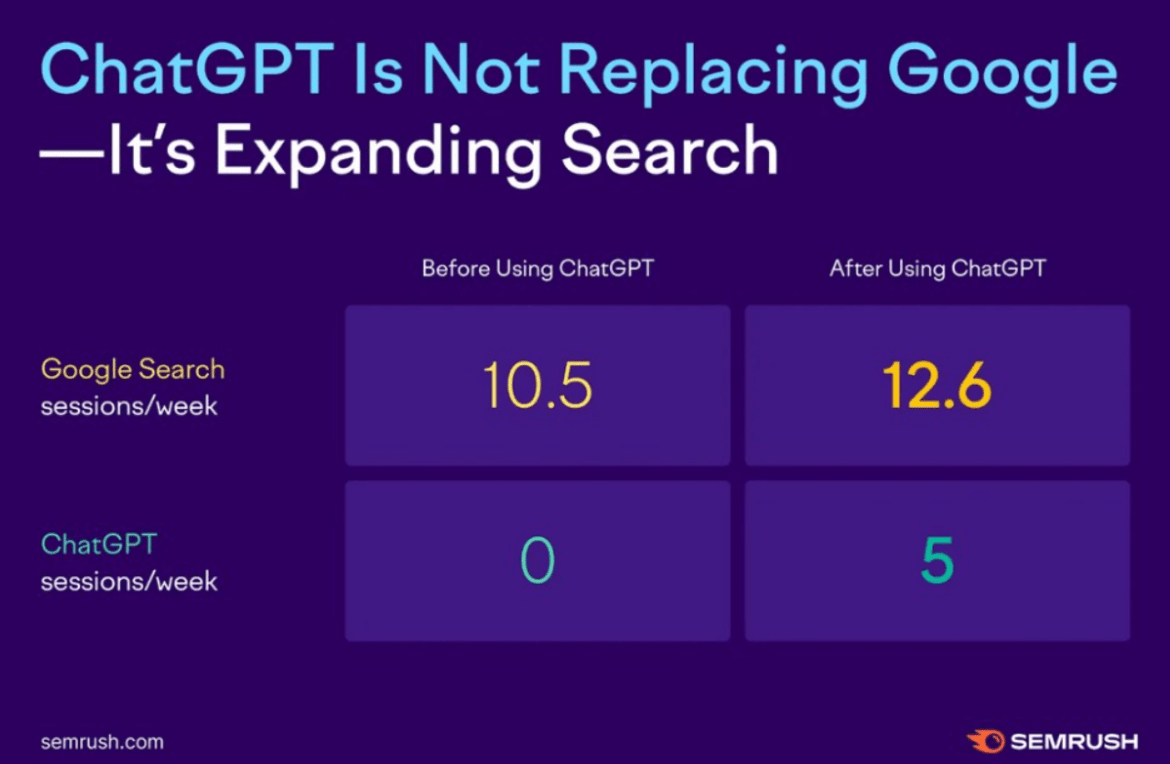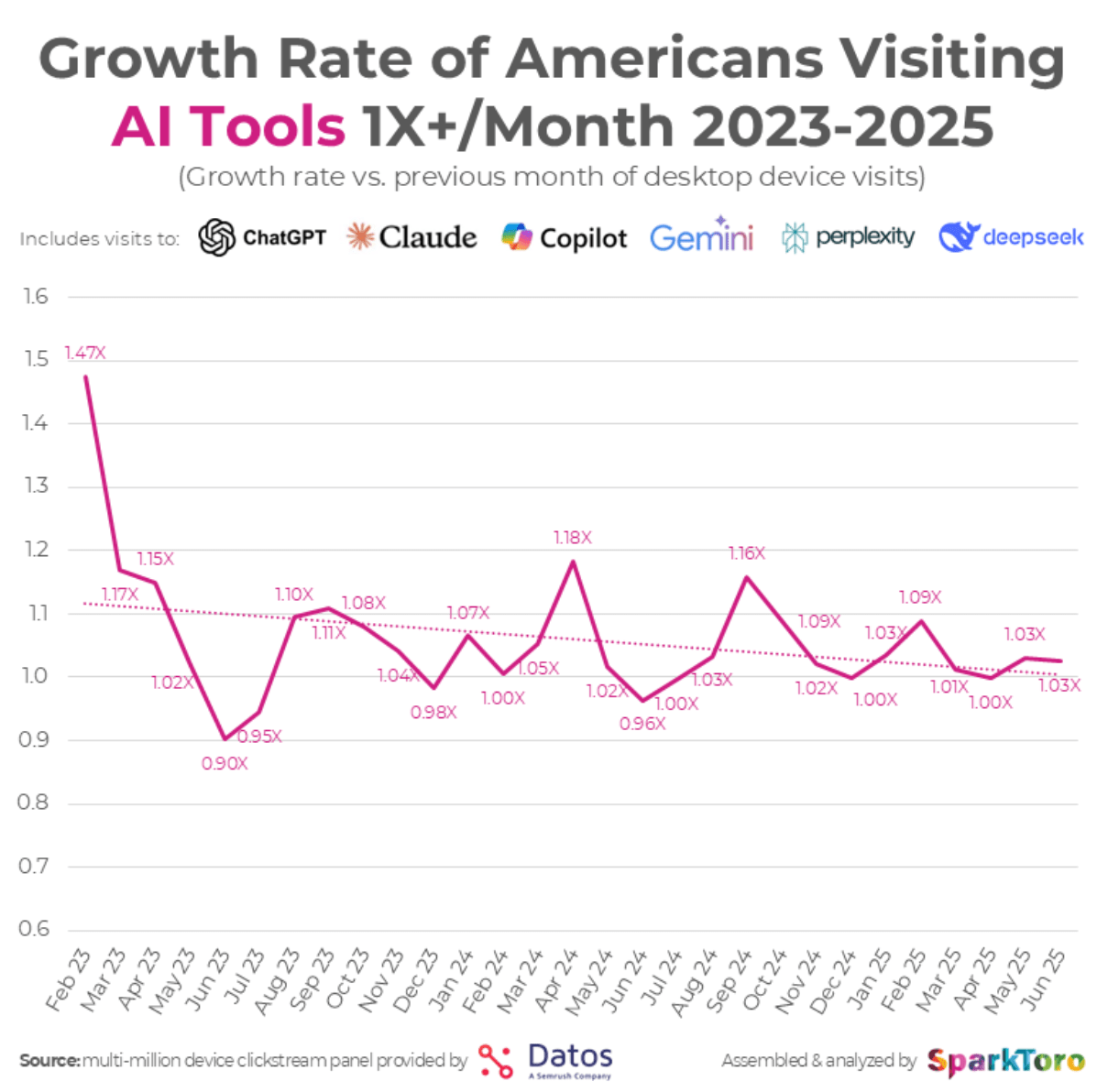Amid the surge of generative AI and hype surrounding new search platforms, many of our clients are asking us ‘is AI search replacing traditional SEO?’ There is some fascinating new research from SparkToro and Semrush which is offering some clarifying answers. This research is showing that AI search is proving to be additive, rather than a replacement for traditional search; which means that SEO continues to be an essential part of any marketing strategy.
SparkToro have used Clickstream data from Datos to pull together some insightful stats to explore what’s actually going on with the growth of AI tools vs the ‘traditional’ search engines, in the United States. They have shared some fascinating findings…
1. Traditional search is strong… and AI is the extra channel to watch
- Over 95% of Americans continue to use traditional search engines every month which is down by less than 1% over the past 2.5 years; even as AI tool use has increased from 8% to 38% over the same period.
- Traditional search usage actually grew with ‘heavy’ search (seen as visiting 10 times or more a month), increasing from 84% in Q1 of 2023 to 87% in Q1 of 2025.

What this shows is that people are using a mix of platforms to find answers, connect with brands and make purchasing decisions. It also emphasises that traditional SEO remains crucial, and AI search is now emerging as an additional channel rather than a replacement. For businesses, the key is to recognise that both matter and you will need to balance both traditional SEO while also helping navigating AI search to ensure your wider marketing and search strategies are future ready.
2. ChatGPT users are not abandoning Google
Semrush’s analysis of over 260 billion rows of clickstream data between January 2024 and June 2025, provides another useful source and lens on this. Their study compared the search behaviour of ChatGPT users with those who have not adopted the tool.
The data shows that after people begin using ChatGPT, their Google search sessions remain steady or even increase slightly. In other words, ChatGPT use does not reduce traditional search behaviour. Instead, it suggests that people are layering AI tools on top of their existing habits, turning to different platforms for different needs.

3. AI tool adoption has grown… but growth is slowing
The research from SparkToro also shows that AI tool adoption has risen sharply since 2023. Heavy AI tool usage (which is defined as 10 or more times a month) has grown from 3% of Americans in early 2023 to 21% by mid 2025, with overall adoption climbing from 8% to 38%.

However, growth is no longer accelerating at the same pace. SparkToro point out that since September 2024, none of the AI tools they analysed (including ChatGPT, Claude, Copilot, Gemini, Perplexity and Deepseek), have experienced a growth month greater than 1.1x. This may indicate that adoption is reaching a saturation point among early adopter groups, for example knowledge workers, while the wider mainstream audience is slower to take up these tools.
What this all means for marketers
The combined findings from SparkToro and Semrush underline a clear message; AI tools are expanding the way people search for information, but they are not replacing the traditional search engines.
For businesses, this means:
- SEO remains critical and foundational. Traditional search is still where most people start and it continues to grow in heavy use.
- AI search is a new, additional channel to consider. See it as another layer in your audience’s discovery journey. This then requires new ways of thinking about your content visibility and it’s optimisation.
- A dual approach is now essential. Successful brands need to maintain strong SEO while also preparing for the opportunities presented by AI-driven search environments. This is where our new AI Visibility Framework is proving to be helpful. Our expertise in SEO ensures clients continue to perform in traditional search, while our AI Visibility services help organisations understand and capture visibility in these emerging platforms.
3 practical steps to take now
- Keep investing in SEO
The data could not be clearer. Traditional search engines remain the dominant way that people find information, products and services online. Not only is usage holding steady, but ‘heavy’ search is actually growing. This means SEO should remain at the heart of your digital strategy. Continue to invest in high quality, optimised content, solid technical foundations and authority building activities that make your brand visible where it matters.
- Add AI search to your marketing mix
While AI tools are not replacing traditional search, they are becoming part of the discovery journey. Users are turning to ChatGPT, Gemini, Copilot and other platforms to complement their searches, and brands need to be visible there too. Start by experimenting: search for your brand, your competitors and your sector keywords in these AI tools. See how the results are presented, and identify ways to adapt your content so that your business is included in these conversations.
- Benchmark and track
Audience behaviours are evolving. The way people balance their use of Google, Bing and AI assistants is shifting, and it will continue to shift over the coming years. Businesses that regularly measure where their visibility comes from will be better placed to adapt. Build benchmarks now, track how your audience is engaging across both traditional and AI platforms, and refine your strategy as the landscape develops. Our AI Visibility Frameworks can help you with this.
The research from SparkToro and Semrush makes it clear that we are not entering a world of “AI versus SEO”, but instead it is one where both will coexist. Traditional search is still strong, and AI search is emerging as an additional layer of opportunity. Businesses that embrace both will be best positioned to thrive.
If you need help future-proofing your website, get in touch with our helpful experts.


